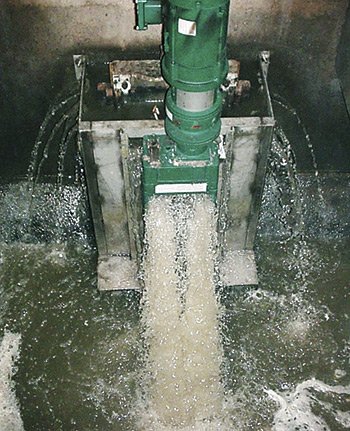Disposable wipes and other non-dispersible products are the modern-day curse for older wastewater lift stations and pumps.
JWC Environmental
09/13/2016
The composition of modern sewage is vastly different than influent from a few decades ago. Pump stations, headworks facilities and other equipment within water resource recovery facilities (WRRFs) were not designed to handle it. One of the biggest culprits is the increased use of flushable consumer wipes and other non-dispersible fabrics that end up in the waste stream. These items eventually clog pumps, pipelines and sensitive treatment equipment. Combined with the vast deterioration and disrepair of the North American wastewater system, municipalities require cost-effective, reliable solutions to deal with tough debris and protect downstream equipment—without the luxury of a total system retrofit.
.jpg) Image 1. Wipes can reweave into large mats in wet wells. (Images courtesy of JWC Environmental)
Image 1. Wipes can reweave into large mats in wet wells. (Images courtesy of JWC Environmental)Dealing with Disposable Wipes
Disposable wipes and other non-dispersible products are a modern-day curse for older wastewater lift stations and pumps that move sewage through collection networks. Lift station pumps are designed to handle traditional wastewater solids, with some handling spherical solids up to 3 inches in diameter—about the size of a baseball..jpg) Image 2. Washer compactors with grinders produce dry and compact screening with low fecal content.
Image 2. Washer compactors with grinders produce dry and compact screening with low fecal content..jpg) Image 3. Grinders designed for inlet channels can handle tough solids
and wipes.
Image 3. Grinders designed for inlet channels can handle tough solids
and wipes.Helping the Headworks
It is not just the older collection systems that suffer from disposable wipes. Outdated technologies at the headworks can lead to maintenance headaches and inefficient plant operations. Bar- or rake-style screens that use only vertical bars to collect solids are often required to remove large debris, but they are not suited for effective removal of wipes. Regardless of how close the bars are spaced, some allow an unacceptable amount of wipes into the plants. The results can be devastating for primary treatment and sludge systems. An automated fine-screening solution is one upgrade to keep disposable wipes out of WRRFs. Fine screens are designed with two directional screening panels typically made from perforated stainless steel or high-strength plastics. The two directional fine screens using 6-millimeter-or-less hole sizes remove smaller pieces of trash, such as rags, wipes, cotton swabs, plastics and latex that can easily pass through traditional bar screens. In-to-out fine screen layouts such as band screens or drum screens offer effective capture of solids because of their non-carry-over design, which is better equipped to protect downstream high-tech treatment equipment such as membrane bioreactors (MBRs). MBR manufacturers frequently recommend a band screen or drum screen with 1- to 2-millimeter perforations to prevent small trash and hair from fouling the membranes’ pores..jpg) Image 4. Washer compactor works with band screen in Bend, Oregon
Image 4. Washer compactor works with band screen in Bend, Oregon.jpg) Image 5. Unprotected pumps can be overwhelmed by rag balls.
Image 5. Unprotected pumps can be overwhelmed by rag balls.Downstream Improvements
Faced with aging headworks infrastructure and an inability to deal with the increase in wipes, managers of the wastewater treatment plant in Oconto, Wisconsin, took steps to address the problems. The plant had been experiencing inefficient performance and ongoing maintenance from its automated bar screen. After only five years in operation, the screening system was worn out and had lost several lifting teeth. The extreme gaps in the filter screen allowed whole rags and piles of fecal matter to pass through unobstructed. Along with the damage caused downstream, mangers faced overpowering odors at the headworks facility caused by the debris the screen pulled from the channel. Image 6. Grinders can be retrofitted to wet wells to protect existing pumps.
Image 6. Grinders can be retrofitted to wet wells to protect existing pumps.
